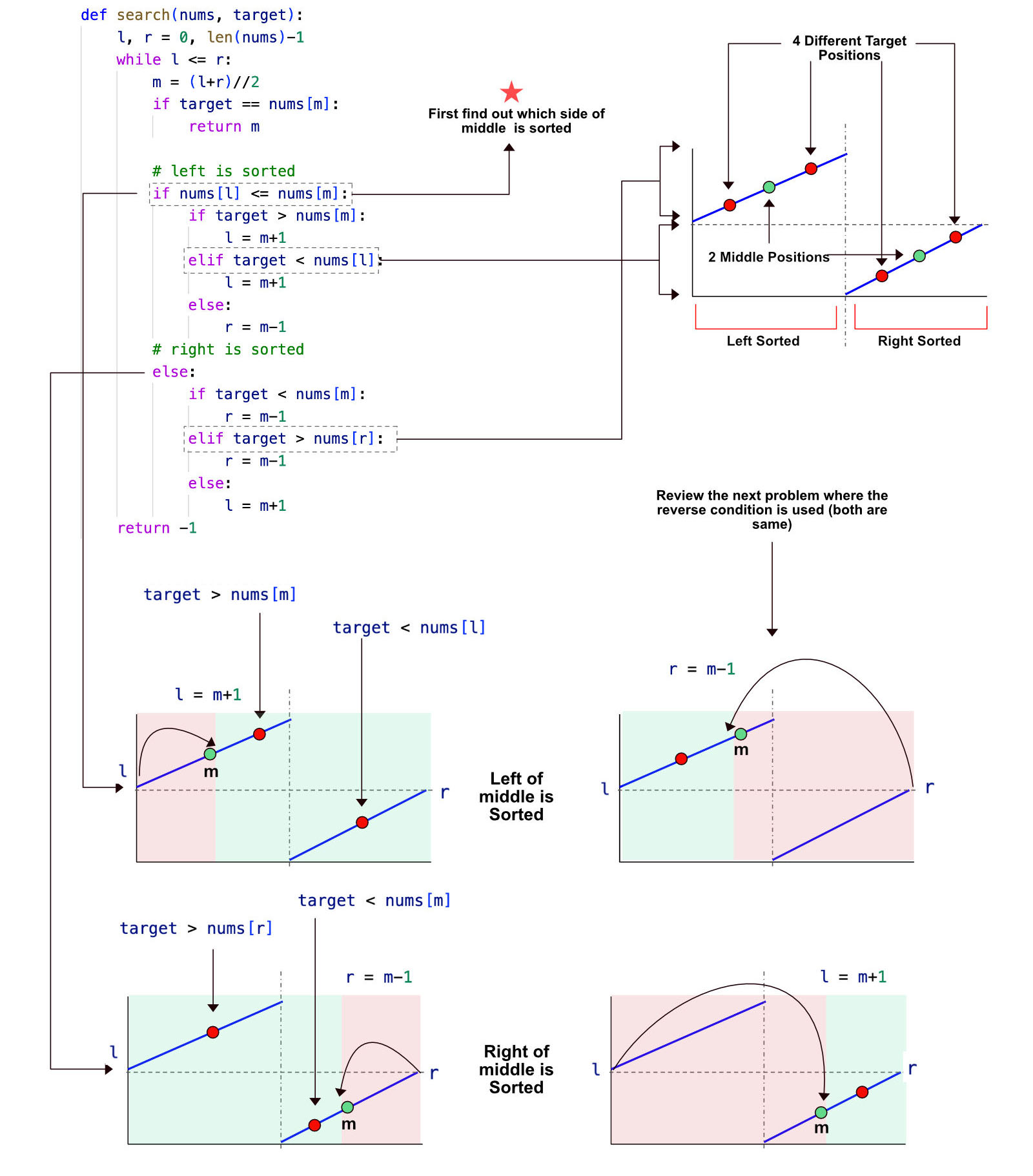Binary Search - Search in Rotated Sorted Array
All diagrams presented herein are original creations, meticulously designed to enhance comprehension and recall. Crafting these aids required considerable effort, and I kindly request attribution if this content is reused elsewhere.
Difficulty : Easy
Binary Search, First find which side is sorted
Problem
Given the array nums after the possible rotation and an integer target, return the index of target if it is in nums, or -1 if it is not in nums.
Example 1:
- Input : nums =
[4,5,6,7,0,1,2], target =0 - Output :
4
Solution
- We need to run a modified binary search for solving this.
- First need to find which side of middle is sorted & then based on it check for the conditions.
Its very important to understand the above 4 diagrams. They shows the logic on how to move l and r pointers.
Code 1
1
2
3
4
5
6
7
8
9
10
11
12
13
14
15
16
17
18
19
20
21
22
23
24
25
26
27
28
29
30
31
32
33
34
35
36
37
38
39
40
41
42
43
44
45
46
47
48
49
50
def rotated_search(nums, target):
l, r = 0, len(nums) - 1
while l <= r:
mid = (l + r) // 2
# Return if target is found
if target == nums[mid]:
return mid
# If left is smaller than middle then
# left of the middle is sorted.
if nums[l] <= nums[mid]:
# there are three loctions where
# the trget could be present.
# We need to check for all three
if target > nums[mid]:
# 1. Target is right of middle and
# in the same partition
# In this case move left to mid +1
l = mid + 1
elif target < nums[l]:
# 2. target is in the right partition
# In this case move the left to mid+1
l = mid + 1
else:
# 3. Target is left of middle in the same
# sorted partition
# In this case move right to mid-1
r = mid - 1
else:
# The right of the middle is sorted.
# Again check for three conditions.
if target < nums[mid]:
# 1. Target is in the left of the
# middle and in same partition
# In this case move right to mid-1
r = mid - 1
elif target > nums[r]:
# 2. Target is in the other partition
# In this case move right to mid-1
r = mid - 1
else:
# 3. Target is right of middle in the
# same sorted partition
# In this case move left to mid+1
l = mid + 1
return -1
print(rotated_search([4,5,6,7,0,1,2],0))
1
4
Code 2
Here is the alternative code using the reversed condition in line 16 and 24.
1
2
3
4
5
6
7
8
9
10
11
12
13
14
15
16
17
18
19
20
21
22
23
24
25
26
27
28
29
def rotated_search(nums, target):
l, r = 0, len(nums) - 1
while l <= r:
mid = (l + r) // 2
# Return if target is found
if target == nums[mid]:
return mid
# If left is smaller than middle then
# left of the middle is sorted.
if nums[l] <= nums[mid]:
# there are three loctions where
# the trget could be present.
# We need to check for all three
if nums[l] <= target < nums[mid]:
r = mid-1
else:
l = mid+1
else:
# The right of the middle is sorted.
# Again check for three conditions.
if nums[mid] < target <= nums[r]:
l = mid+1
else:
r = mid-1
return -1
print(rotated_search([4,5,6,7,0,1,2],0))
1
4
Runtime Complexity
The runtime will be O(log n) as we are simply running a binary search.
This post is licensed under CC BY 4.0 by the author.
